One of the first things I do when I get back from a trip is to check on the garden. Has anything changed? Have new flowers opened up? Has there been any damage? Etc. etc. Me being me, anticipation is always tinged with a dose of worry.
My recent trip to San Diego was less than a week, but thanks to warm and sunny weather, many aloes in our garden are near their peak bloom. That may not last long, seeing how we're in the throes of a brief but nasty arctic cold snap. As I described in this post, I slipped Styrofoam cups over emerging aloe flowers to protect them against the worst. That's the best I can do on short notice. I don't have enough frost blankets to cover every flowering aloe.
But back to what the aloes (and other plants) looked like on my return from San Diego:
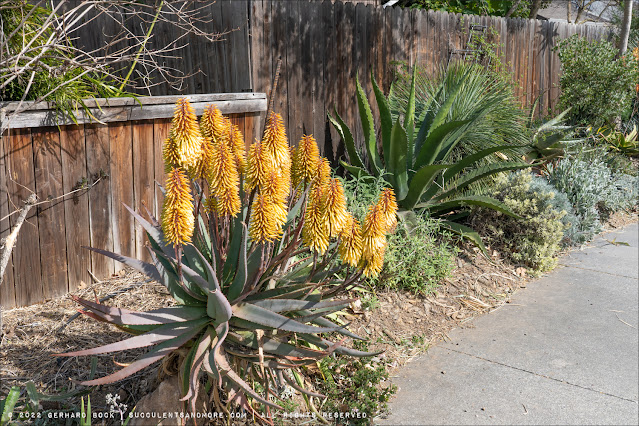 |
| Aloe 'Moonglow' clump #1, with Agave gentryi 'Jaws' and Yucca linearifolia to the right |
 |
| Further on down the line, Aloe 'Moonglow' clump #2 (with clump #3 peeking out near the mailboxes all the way on the right) |
 |
| Blooming in the foreground (photo on the left) is an Aloe bulbillifera hybrid, with Aloe hereroensis (pink leaves) and Aloe petricola next to it |
 |
| Aloe 'Moonglow' clump #2 with Agave macroacantha on the left, and Yucca rostrata and Agave americana 'Mediopicta alba' on the right |
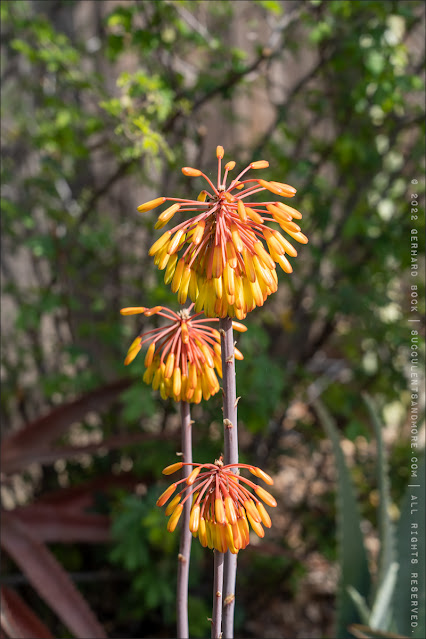 |
| Mop-top flowers of Aloe capitata var. quartziticola |
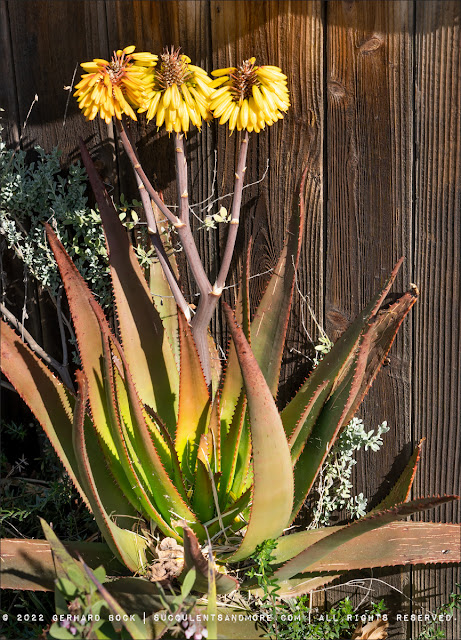 |
| Aloe capitata × Aloe ferox (white-flowering form) |
 |
| Aloe capitata 'Yellow Hoodie', a tissue-cultured selection from Rancho Tissue. It's pretty, but maybe not special enough to warrant such a prominent spot. We shall see. |
 |
| Aloe 'Tangerine', on the other hand, is here to stay |
 |
| ×Mangave 'Queen for a Day', a sport of 'Mayan Queen' with purplish margins and olive-green centers. It's still growing out of the bruises sustained during shipping, but its potential is undeniable. |
 |
| Aloe speciosa × barberae, a hybrid created by the intrepid Nick Deinhart, is one of my favorite aloes. I love the large bicolored inflorescence. |
 |
| Aloe speciosa × barberae, with Aloe cameronii in the background |
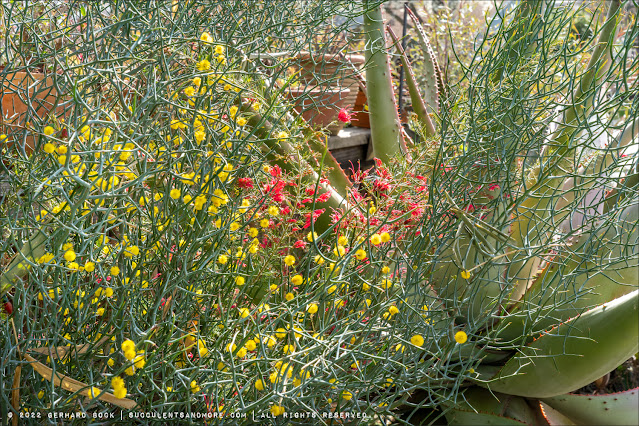 |
| Acacia aphylla started flowering while I was in San Diego. Its leafless branchlets form a blue-green tangle, which is always attractive but even more so now. The reddish flowers belong to Grevillea rosmarinifolia 'Scarlet Sprite'. |
 |
| Grevillea rosmarinifolia 'Scarlet Sprite', Acacia aphylla, and Aloe vaombe |
 |
| Acacia aphylla and Aloe vaombe |
 |
| Peek through the trio of ponytail palms (Beaucarnea recurvata) |
 |
| Aloe betsileensis flowering for the first time. To the left is Aloe 'AJR', which has proven itself to be an impressive performer, flowering repeatedly throughout the year. The little pink flowers are Oscularia caulescens, a South African ice plant lookalike. |
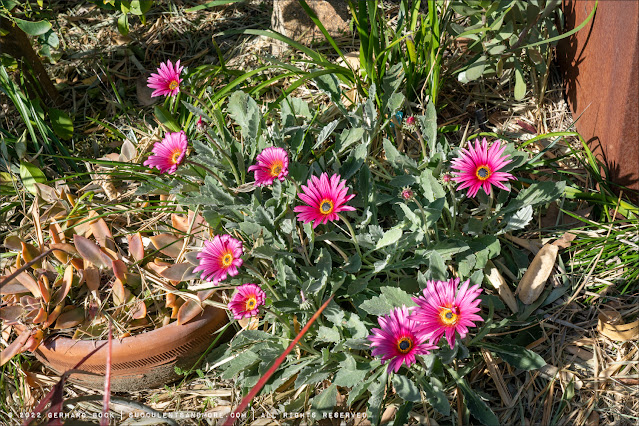 |
| Speaking of pink, this is Arctotis 'Ultra Violet' flowering for the first time. Like all African daisies, it responds well to deadheading. I just need to remember to actually do it! |
 |
| One Lachenalia aloides var. quadricolor planted in February 2016, i.e. 6 years ago, has now become a small colony. This is one of my favorite South African bulbs. |
 |
| Lachenalia aloides var. quadricolor in front of Hechtia 'Silver Star' |
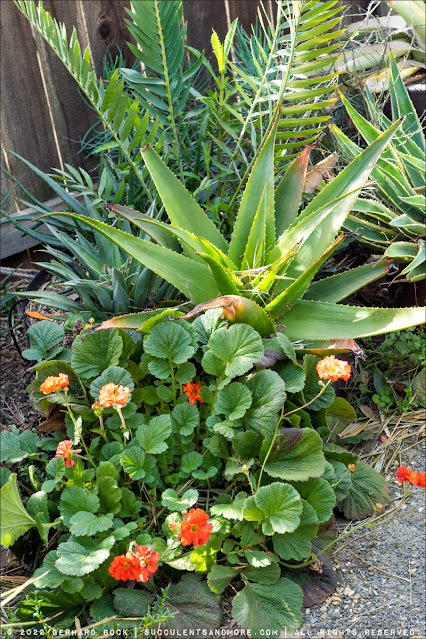 |
| Geum 'Scarlet Tempest' starts flowering early and doesn't stop until late fall. Behind it is Aloe lukeana. |
 |
| This is Agave dasylirioides in the backyard. It has a drooping inflorescence that almost touches the ground. A flowering agave is always a garden highlight, bittersweet as it is (most agave species die after flowering, this one included). |
 |
| Aloe divaricata. This is cheating a bit because it's a purchase from San Diego and hasn't been planted yet, but it fits right into the garden. |
 |
| Check out the remarkable fused teeth! |
I just realized that this post is very flower-centric. While this wasn't my intention, it underscores how bloomiferous our garden is in winter. Bees, hummingbirds, and other critters sure are happy. I look at neighboring yards where nothing is in bloom, and it thrills me to know that we provide food for pollinators even though we didn't set out to create a pollinator garden per se.
© Gerhard Bock, 2022. All rights reserved. To receive all new posts by email, please subscribe here.
























I hope the arctic blast hasn't damaged your beautiful Aloe blooms much. We've been colder-than-usual too but we haven't had any freezing level cold. As thrilled as I am that the 'Moonglow' Aloes I planted from cuttings in the fall bloomed this year, I look forward to spectacular displays like yours in future years. The spiraled bicolored flowers on your hybrid Aloe are very intriguing. As to the Lachenalia, I hope my bulbs bulk up and bloom like yours in time - this year's display was underwhelming.
ReplyDeleteAloe 'Moonglow' gets better every year. This year has been the most spectacular yet.
DeleteThe same goes for lachenalias. Just give them time.
Hopefully not much damage to the flowers after your chilly nights. We were down to the low 40s is all. Enjoyed seeing all your Aloe flowers. Plants (and flowers) look really good.
ReplyDeleteMy 'Fire Ranch' just sent up its flower stem.
We got down to 29°F one night, but no severe damage, at least none that has manifested yet.
DeleteGotta check your blog for photos of 'Fire Ranch'. No activity on my plant. I've never, ever had an inflorescence on 'Fire Ranch'. If it doesn't bloom this year, I'll replace it with the Aloe divaricata I bought in San Diego.
"Bloomiferous" is a word I can break my teeth on, but it's oh so fun. I can't deny Aloe 'Moonglow' it's due; it has a festive bright presence that lights up the sidewalk bed. Still, Aloe 'Tangerine' is my favorite; my heat skip a beat when I see the orange-red bloom contrasts with the blue tone of the leafs.
ReplyDeleteI love the shot through the ponytail palms: could have been my own garden, if Seattle was a warmer zone :-D
The drooping inflorescence of Agave dasylirioides is very unusual.
Is it bloomiferous or bloomerific? Or both?
Delete'Tangerine' is a fave of mine, too. The color is so saturated!
In a few years, you might be able to grow ponytail palms outside in Seattle :-(
The beauty of your streetside garden just gets better and better. How lucky those in your neighborhood are to drive by it.
ReplyDelete×Mangave 'Queen for a Day' is HOT! And the Agave dasylirioides bloom is stunning.
Thank you! People do stop and tell us how much they enjoy our garden. Hearing that warms my heart. Any streetside garden is a shared space to a point.
Delete